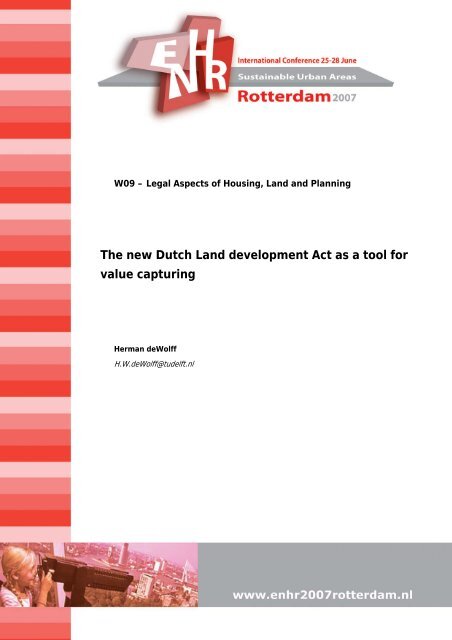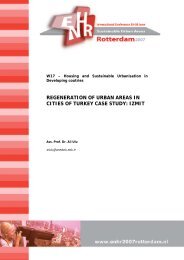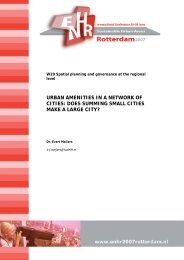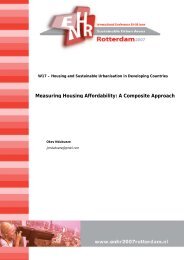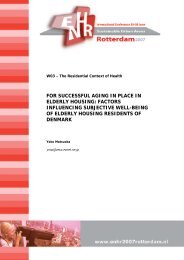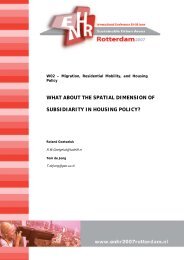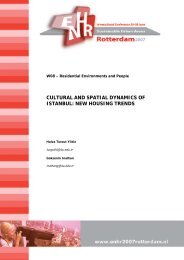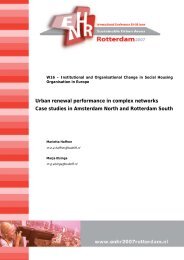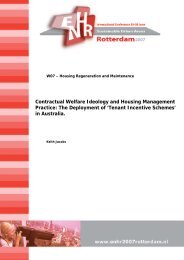The new Dutch Land development Act as a tool for value capturing
The new Dutch Land development Act as a tool for value capturing
The new Dutch Land development Act as a tool for value capturing
Create successful ePaper yourself
Turn your PDF publications into a flip-book with our unique Google optimized e-Paper software.
W09 – Legal Aspects of Housing, <strong>Land</strong> and Planning<br />
<strong>The</strong> <strong>new</strong> <strong>Dutch</strong> <strong>Land</strong> <strong>development</strong> <strong>Act</strong> <strong>as</strong> a <strong>tool</strong> <strong>for</strong><br />
<strong>value</strong> <strong>capturing</strong><br />
Herman deWolff<br />
H.W.deWolff@tudelft.nl
<strong>The</strong> <strong>new</strong> <strong>Dutch</strong> <strong>Land</strong> <strong>development</strong> <strong>Act</strong> <strong>as</strong> a <strong>tool</strong> <strong>for</strong> <strong>value</strong> <strong>capturing</strong><br />
ENHR 2007 International Conference ‘Sustainable Urban Are<strong>as</strong>’<br />
<strong>The</strong> <strong>new</strong> <strong>Dutch</strong> <strong>Land</strong> <strong>development</strong> <strong>Act</strong><br />
<strong>as</strong> a <strong>tool</strong> <strong>for</strong> <strong>value</strong> <strong>capturing</strong><br />
Herman deWolff<br />
OTB Research Institute <strong>for</strong> Housing, Urban and Mobility Studies<br />
Delft University of Technology, H.W.deWolff@tudelft.nl<br />
Phone +31-15-2783668 / Fax +31-15-278 2745<br />
Keywords: <strong>value</strong> <strong>capturing</strong>; land <strong>development</strong>; cost recovery<br />
In several European countries in recent years house prices have risen sharply. On the land<br />
market, this h<strong>as</strong> lead to an incre<strong>as</strong>e of the plus <strong>value</strong>, the gap between the agricultural <strong>value</strong> of<br />
land and the <strong>value</strong> of land to be urbanised. Because of this incre<strong>as</strong>e, in several countries the<br />
possibilities to profit from this plus <strong>value</strong> have (again) become an issue <strong>for</strong> the government.<br />
Also in the Netherlands, the plus <strong>value</strong> h<strong>as</strong> been debated <strong>as</strong> a result of the Memorandum of<br />
central government on <strong>Land</strong> Policy (Nota Grondbeleid), which h<strong>as</strong> been published in 2001.<br />
However, the government decided on an approach in which <strong>capturing</strong> the plus <strong>value</strong> will not<br />
be followed.<br />
A <strong>new</strong> legal system, the so–called <strong>Land</strong> <strong>development</strong> <strong>Act</strong> (Grondexploitatiewet), an<br />
amendment of the (<strong>new</strong>) Spatial Planning <strong>Act</strong> (Wet ruimtelijke ordening), will come into<br />
<strong>for</strong>ce in 2008. This <strong>Act</strong> will strengthen the position of the government in land <strong>development</strong>.<br />
As far <strong>as</strong> the plus <strong>value</strong> is concerned, the proposed <strong>Act</strong> chooses a strategy b<strong>as</strong>ed on cost<br />
recovery: the government is able to <strong>for</strong>ce the developer to pay <strong>for</strong> certain costs and (public)<br />
facilities.<br />
In the paper, the main characteristics of this <strong>new</strong> <strong>Act</strong> are presented. <strong>The</strong> paper argues that,<br />
although the <strong>new</strong> system is <strong>for</strong>mally b<strong>as</strong>ed on the principle of cost recovery, the system also<br />
h<strong>as</strong> some similarities with a system in which the central approach is b<strong>as</strong>ed on <strong>capturing</strong> (part<br />
of) the plus <strong>value</strong>.<br />
Introduction<br />
Rise of house prices<br />
In several European countries in recent years house prices have risen sharply. For example, in<br />
the Netherlands, the <strong>development</strong> of the real price of existing one-family dwellings in the<br />
period 1995 – 2003 w<strong>as</strong> +67% (National Board of Housing, Building and Planning, Sweden<br />
et al, 2005). Also in <strong>for</strong> example the UK (+110%), Spain (+78%), France (+26%), Belgium<br />
(+21%) the <strong>development</strong> of house prices w<strong>as</strong> relatively high. If <strong>new</strong>ly built houses are subject<br />
to the same market regime and are competitive with the existing housing stock, this rise of<br />
house prices will in general be also applicable on <strong>new</strong>ly built houses.<br />
Several explanations are offered <strong>for</strong> these changes in house prices. (Boelhouwer et al., 2004)<br />
introduce, b<strong>as</strong>ed on a literature study, arguments from the Neo-cl<strong>as</strong>sical Price <strong>The</strong>ory,<br />
speculative or psychological effects, economic <strong>development</strong>s, demographic factors and<br />
Workshop: Legal Aspects of Housing, <strong>Land</strong> and Planning<br />
Author: Herman de Wolff<br />
1
<strong>The</strong> <strong>new</strong> <strong>Dutch</strong> <strong>Land</strong> <strong>development</strong> <strong>Act</strong> <strong>as</strong> a <strong>tool</strong> <strong>for</strong> <strong>value</strong> <strong>capturing</strong><br />
institutional policies. According to this research, the incre<strong>as</strong>e in constructions costs is only<br />
one of many possible explanations of the <strong>development</strong> in house prices. In (National Board of<br />
Housing, Building and Planning, Sweden et al, 2005) some quantitative evidence of this<br />
statement can be found: the rise in construction costs in <strong>for</strong> example the Netherlands is only<br />
+20% in the period 1995-2003.<br />
Plus <strong>value</strong><br />
For <strong>new</strong>ly built houses, this often means that – with the rise of the house prices - the residual<br />
<strong>value</strong> of the land that is developed also rises. This can be explained by the scarcity of building<br />
land: because only a limited amount of building land is available, the developer is prepared to<br />
pay more <strong>for</strong> the land than the agricultural <strong>value</strong>. <strong>The</strong> amount of money he is prepared to pay,<br />
is b<strong>as</strong>ed on the expected profit of the <strong>development</strong>, taking into account the risk of the<br />
<strong>development</strong>.<br />
In such a c<strong>as</strong>e, the gap between the agricultural <strong>value</strong> of land and the <strong>value</strong> of land to be<br />
urbanised (the residual <strong>value</strong> of the land) h<strong>as</strong> incre<strong>as</strong>ed, in c<strong>as</strong>e other <strong>development</strong> costs do<br />
not rise disproportionately. This gap is a reality, if a planning system enables the government<br />
to regulate the conversion from agricultural to building land. However, the determination of<br />
this gap can be rather complex, and depends amongst others on the planning system and<br />
planning practice of the country involved. In many countries, despite the fact that the planning<br />
rules in <strong>for</strong> example the urban fringe <strong>for</strong>bid the change of land use, still the prices of<br />
agricultural land will rise because of the expected change of the use possibilities of the land,<br />
<strong>as</strong> <strong>for</strong> example (Plantinga et al., 2002) show <strong>for</strong> the US agricultural land market.<br />
<strong>The</strong> gap between the agricultural <strong>value</strong> of the land and the <strong>value</strong> of the land to be urbanised,<br />
in this article is defined <strong>as</strong> the plus <strong>value</strong>.<br />
Besides the agricultural landowner, the different parties involved in the <strong>development</strong> process<br />
are candidate to have a share in these plus <strong>value</strong>. (De Greef, 1997) distinguishes between<br />
three types of market segments within the <strong>development</strong> market: the housing market, the<br />
building market and the land market. <strong>The</strong> parties that play a role in these three market<br />
segments might profit from the plus <strong>value</strong>. For example, if the selling price of a <strong>new</strong> built<br />
house is below the real market <strong>value</strong>, the <strong>new</strong> owner-occupier will profit from a part of the<br />
plus <strong>value</strong>. Or, if the selling price of the house is higher than the costs <strong>for</strong> constructing the<br />
house and the costs <strong>for</strong> buying a (serviced) building lot, the private developer or the building<br />
company will profit. And, if the selling price of a serviced plot is higher than the agricultural<br />
<strong>value</strong> of the land plus the cost <strong>for</strong> servicing the plot (taking into account the land which can<br />
not be sold because it is necessary <strong>for</strong> public services), the original landowner or the land<br />
developer will profit from a part of the plus <strong>value</strong>.<br />
Content of the article<br />
Also the government can be one of the parties that profits from this plus <strong>value</strong>. This article<br />
focuses on a <strong>new</strong> strategy <strong>for</strong> (partly) <strong>capturing</strong> the plus <strong>value</strong> of the land in the Netherlands,<br />
b<strong>as</strong>ed on a proposed change of the legal system, the so–called <strong>Land</strong> <strong>development</strong> <strong>Act</strong><br />
(Grondexploitatiewet), an amendment of the (<strong>new</strong>) Spatial Planning <strong>Act</strong> (Wet ruimtelijke<br />
ordening), which will come into <strong>for</strong>ce in 2008.<br />
In this article, first some attention is given to <strong>value</strong> <strong>capturing</strong> in a wider perspective. After<br />
this, the main characteristics of the land <strong>development</strong> context in the Netherlands are<br />
introduced and a brief overview of the present legal system regarding land <strong>development</strong> is<br />
given. Next, the paper focuses on the <strong>new</strong> <strong>Act</strong> and the main characteristics of this <strong>Act</strong>. After<br />
Workshop: Legal Aspects of Housing, <strong>Land</strong> and Planning<br />
Author: Herman de Wolff<br />
2
<strong>The</strong> <strong>new</strong> <strong>Dutch</strong> <strong>Land</strong> <strong>development</strong> <strong>Act</strong> <strong>as</strong> a <strong>tool</strong> <strong>for</strong> <strong>value</strong> <strong>capturing</strong><br />
that, the paper evaluates the <strong>new</strong> <strong>Act</strong>. To what extent can the <strong>Act</strong> be seen <strong>as</strong> a <strong>tool</strong> <strong>for</strong> <strong>value</strong><br />
<strong>capturing</strong>?<br />
Value <strong>capturing</strong><br />
Value <strong>capturing</strong> can be seen <strong>as</strong> a method or a strategy to capture (part of) the <strong>value</strong> incre<strong>as</strong>e to<br />
use it <strong>for</strong> a specific purpose.<br />
(Smolka, 2000) defines <strong>value</strong> capture <strong>as</strong> “…the process by which a portion of or all land <strong>value</strong><br />
increments attributed to the ‘community ef<strong>for</strong>t’ are recouped by the public sector either<br />
through their conversion into public revenues through taxes, fees, exactions and other fiscal<br />
means or more directly in on-site land improvements <strong>for</strong> the benefits of the community”. He<br />
distinguishes three types of <strong>tool</strong>s <strong>for</strong> <strong>value</strong> <strong>capturing</strong>: taxes, fees and regulatory instruments<br />
(<strong>for</strong> a variant of “in kind” contribution).<br />
Taking different existing systems into account, some remarks on this definition can be made:<br />
• <strong>The</strong> above-mentioned definition is b<strong>as</strong>ed on the situation that a private developer will<br />
develop the land himself. However, there appears to be another important strategy <strong>for</strong><br />
<strong>value</strong> <strong>capturing</strong>: active land <strong>development</strong>. In that c<strong>as</strong>e, the government is directly<br />
involved in land <strong>development</strong>, trying to acquire land to be urbanised. As a developer,<br />
the government can capture the <strong>value</strong> incre<strong>as</strong>e directly. This strategy is (still) often<br />
followed in the Netherlands.<br />
• In the definition, three types of <strong>tool</strong>s <strong>for</strong> <strong>value</strong> <strong>capturing</strong> (taxes, fees and regulatory<br />
instruments) are distinguished. Besides these three, also the agreement can be an<br />
important <strong>tool</strong> <strong>for</strong> <strong>value</strong> <strong>capturing</strong>, <strong>for</strong> example the Planning Agreement in the UK.<br />
Besides this, sometimes a more integrated land <strong>development</strong> procedure exists, of<br />
which <strong>value</strong> <strong>capturing</strong> is one of the issues addressed (<strong>for</strong> example land readjustment –<br />
the German Umlegung). And <strong>as</strong> far <strong>as</strong> <strong>value</strong> <strong>capturing</strong> using active land <strong>development</strong><br />
is concerned, also the instruments <strong>for</strong> acquiring land are relevant (and in using these<br />
instruments the way the price to be paid is determined).<br />
• <strong>The</strong> definition indicates that the rationale behind <strong>value</strong> <strong>capturing</strong> is the community<br />
ef<strong>for</strong>t; the revenues should benefit the community. In the debate in the Netherlands<br />
also some other rationales are introduced.<br />
In the debate about “open space tax” in the Netherlands, four different motives are<br />
introduced (Korthals Altes, <strong>for</strong>thcoming): (1) internalizing welfare losses resulting<br />
from the <strong>for</strong>mer users of the open space, (2) negative taking tax (if the government<br />
pays <strong>for</strong> compensation, than also the opposite should be possible), (3) an instrument<br />
to steer the <strong>development</strong> towards building on previously developed land and (4)<br />
acquiring money <strong>for</strong> the public purse.<br />
In a research project on cost recovery and cross subsidizing in regional <strong>development</strong>,<br />
<strong>as</strong> the result of an <strong>as</strong>sessment of different opinions of some key-actors, four motives<br />
are distinguished b<strong>as</strong>ed on their opinions (De Wolff et al, 2004): (1) direct benefit,<br />
limited to situations of exclusive use of the provided service, (2) direct benefit,<br />
including also situations in which other people benefit too, (3) enlarging spatial<br />
quality and internalising external effects of <strong>new</strong> <strong>development</strong> and (4) solidarity: using<br />
profitable projects to make un-economic projects possible.<br />
• <strong>The</strong> definition limits <strong>value</strong> <strong>capturing</strong> to <strong>value</strong> incre<strong>as</strong>e caused by the ‘community<br />
ef<strong>for</strong>t’. <strong>The</strong>se ef<strong>for</strong>ts can be both me<strong>as</strong>ures (e.g. the construction of a road) and<br />
decisions (the decision to change a local binding land use plan).<br />
In this paper, <strong>value</strong> <strong>capturing</strong> is described <strong>as</strong> “…the process by which land <strong>value</strong> increments<br />
attributed to governmental me<strong>as</strong>ures and decisions are (partly) recouped by the public sector<br />
Workshop: Legal Aspects of Housing, <strong>Land</strong> and Planning<br />
Author: Herman de Wolff<br />
3
<strong>The</strong> <strong>new</strong> <strong>Dutch</strong> <strong>Land</strong> <strong>development</strong> <strong>Act</strong> <strong>as</strong> a <strong>tool</strong> <strong>for</strong> <strong>value</strong> <strong>capturing</strong><br />
either through acquiring the land be<strong>for</strong>e me<strong>as</strong>ures and decisions are taken (active land<br />
<strong>development</strong>), either through their conversion into public revenues by having the land owner<br />
pay <strong>for</strong> or take care of some me<strong>as</strong>ures, by following an integrated land <strong>development</strong><br />
procedure, entering into an agreement, levying a tax or obligating the land owner to in kind<br />
contribution.<br />
This paper focuses on the strategy <strong>for</strong> <strong>value</strong> <strong>capturing</strong> in which the government influences<br />
what happens with the plus <strong>value</strong> of land owned by a private landowner.<br />
Within this l<strong>as</strong>t strategy, the outcome depends on the rational <strong>for</strong> <strong>value</strong> <strong>capturing</strong>. If the<br />
rational is the direct benefit principle, often the expression “cost recovery” is used instead of<br />
<strong>value</strong> <strong>capturing</strong>. In that c<strong>as</strong>e, the government obliges the developer to pay <strong>for</strong> certain costs<br />
and (public) facilities or to realise certain facilities himself<br />
If the rational is more comprehensive, than often the expression <strong>value</strong> <strong>capturing</strong> is used. In<br />
that c<strong>as</strong>e, the government captures (part of) the <strong>development</strong> profit or obliges the developer to<br />
take care of some projects of which he h<strong>as</strong> no direct benefit.<br />
In several European countries, <strong>new</strong> instruments <strong>for</strong> <strong>value</strong> <strong>capturing</strong> have been or are debated.<br />
For example in Flanders (Belgium), the Spatial planning decree from 1999 introduces a<br />
planning profit tax; and also in the UK a <strong>new</strong> tax on windfall gains h<strong>as</strong> been proposed (Oxley,<br />
2006). In the rest of this paper, the focus is on the Netherlands. <strong>The</strong> <strong>new</strong> <strong>Dutch</strong> <strong>Land</strong><br />
Development <strong>Act</strong> will be analysed <strong>as</strong> an example of a <strong>new</strong> <strong>tool</strong> <strong>for</strong> <strong>value</strong> <strong>capturing</strong> in the<br />
Netherlands.<br />
<strong>Land</strong> <strong>development</strong> in the Netherlands<br />
Towards <strong>new</strong> <strong>development</strong> strategies<br />
Until 1990, in the Netherlands local government often w<strong>as</strong> the most important party in land<br />
<strong>development</strong>, following a so-called active land <strong>development</strong> strategy. <strong>The</strong> land to be<br />
developed w<strong>as</strong> bought by the local government, who took care of realizing roads, parks and<br />
other public facilities. A large area of building land w<strong>as</strong> sold to housing <strong>as</strong>sociations, to<br />
realize social housing. Often 70% of the houses to be realized were social housing. Housing<br />
w<strong>as</strong> seen <strong>as</strong> a “merit good”: to keep the part of the income to spend on housing relatively low,<br />
the price of the serviced land w<strong>as</strong> kept rather low.<br />
In the beginning of the 1990s, this practice h<strong>as</strong> changed, and private developers became more<br />
and more interested in buying land in are<strong>as</strong> to be urbanised.<br />
One of the re<strong>as</strong>ons w<strong>as</strong> that since 1989 the housing policy of central government h<strong>as</strong> changed.<br />
Granting possibilities from central government to realize social housing were limited. New<br />
houses should <strong>for</strong> the greater part be realized in the market sector. For private developers,<br />
buying land in the <strong>new</strong> urban are<strong>as</strong> became less riskier than in the p<strong>as</strong>t, when owning land on<br />
which housing in the social sector were projected, w<strong>as</strong> rather unple<strong>as</strong>ant. In fact, buying land<br />
w<strong>as</strong> some kind of guarantee <strong>for</strong> participating in the <strong>development</strong> of the area.<br />
<strong>The</strong> presentation of a <strong>new</strong> planning policy document of central government in 1990, the<br />
Fourth Report on Physical Planning Extra (VINEX) (De Wolff, 1999), h<strong>as</strong> been rather<br />
important <strong>for</strong> this change. A main issue in this report w<strong>as</strong> concentration of urbanization in a<br />
limited number of city regions. <strong>The</strong> green and open are<strong>as</strong> in the country should be protected<br />
from further urbanization, and concentration of urbanization should make sufficiently<br />
Workshop: Legal Aspects of Housing, <strong>Land</strong> and Planning<br />
Author: Herman de Wolff<br />
4
<strong>The</strong> <strong>new</strong> <strong>Dutch</strong> <strong>Land</strong> <strong>development</strong> <strong>Act</strong> <strong>as</strong> a <strong>tool</strong> <strong>for</strong> <strong>value</strong> <strong>capturing</strong><br />
profitable public transport facilities possible. Originally, creating scarcity of building land w<strong>as</strong><br />
seen <strong>as</strong> an important policy <strong>tool</strong> <strong>for</strong> the financial fe<strong>as</strong>ibility of the <strong>new</strong> urban are<strong>as</strong>. <strong>The</strong> rise of<br />
the prices of building land w<strong>as</strong> necessary <strong>for</strong> the government to be able to develop the rather<br />
expensive <strong>new</strong> urban are<strong>as</strong>. However, this planning policy also made it rather early clear<br />
which sites would be developed <strong>for</strong> urbanisation. Buying agricultural land in the are<strong>as</strong><br />
involved w<strong>as</strong> there<strong>for</strong>e <strong>for</strong> private developers less risky than it had been in the p<strong>as</strong>t. And,<br />
because the policy also involved a limitation of the are<strong>as</strong> to be developed, buying land<br />
became even more important to be able to participate in the <strong>development</strong> at all.<br />
Sometimes, local government itself <strong>as</strong>ked private developers to participate in land<br />
<strong>development</strong>. <strong>The</strong> relatively poor economic situation in the 1980 h<strong>as</strong> made them rather<br />
reserved against buying land on stock; cooperation with private developers w<strong>as</strong> seen <strong>as</strong> a<br />
possibility to reduce risks <strong>for</strong> the government.<br />
<strong>The</strong>se trends were intensified by <strong>development</strong>s on the housing market. <strong>The</strong> general rise of<br />
house prices made land <strong>development</strong> less risky.<br />
Nowadays the situation on the land market in the Netherlands there<strong>for</strong>e differs from the<br />
situation 20 years ago. More and more parties have become interested in participating in land<br />
<strong>development</strong>.<br />
This <strong>new</strong> situation, <strong>as</strong>ks <strong>for</strong> a reorientation on the position of the government in land<br />
<strong>development</strong>. <strong>The</strong> traditional active land <strong>development</strong> often h<strong>as</strong> to be replaced by a more<br />
facilitating land policy. <strong>The</strong> question who profits from the plus <strong>value</strong> h<strong>as</strong> to be answered in a<br />
different context.<br />
From site <strong>development</strong> towards area <strong>development</strong><br />
In 2004 a <strong>new</strong> memorandum on National Spatial Strategy h<strong>as</strong> been approved by Parliament<br />
(Nota Ruimte, 2006). In the <strong>new</strong> spatial policy, <strong>development</strong> on a regional level is stimulated.<br />
An integrated approach on the regional level is regarded <strong>as</strong> important <strong>for</strong> improving spatial<br />
quality (Korthals Altes, 2006).<br />
One of the conclusions of the <strong>for</strong>mer Spatial Strategy w<strong>as</strong> that in some are<strong>as</strong> the <strong>development</strong><br />
of <strong>new</strong> housing are<strong>as</strong> w<strong>as</strong> not enough connected to the <strong>development</strong> of <strong>for</strong> example<br />
recreational projects or (public) infr<strong>as</strong>tructure projects. If the spatial policymaking is<br />
organised on the regional level, the decision about this kind of projects could be better<br />
connected. But not only the decision-making: also housing and other commercial<br />
<strong>development</strong> projects could contribute financially to make other regional projects fe<strong>as</strong>ible. In<br />
such an area oriented <strong>development</strong> strategy, the concept of <strong>value</strong> <strong>capturing</strong> becomes relevant.<br />
Legal system <strong>for</strong> <strong>value</strong> <strong>capturing</strong> in the Netherlands: current practice<br />
Until now, the general system in the Netherlands is that the <strong>value</strong> incre<strong>as</strong>e of land, caused by<br />
a change of the admitted land use in a legally binding planning document (<strong>for</strong> example from<br />
agricultural land to commercial <strong>development</strong>), falls to the landowner. <strong>The</strong> actual legal<br />
possibilities <strong>for</strong> the government <strong>for</strong> <strong>value</strong> <strong>capturing</strong> in the c<strong>as</strong>e a private land owner develops<br />
the land himself, are mainly limited to cost recovery.<br />
For this situation, two legal instruments are relevant: the so-called <strong>Land</strong> <strong>development</strong><br />
Agreement (Exloitatieovereenkomst) and a cost recovery tax (baatbel<strong>as</strong>ting). <strong>The</strong>se<br />
instruments allow the recovering of costs of (some of) the investments done by the local<br />
government. <strong>The</strong> system is comprehensive: the government cannot use other powers <strong>for</strong> <strong>value</strong><br />
<strong>capturing</strong>, besides these two. So <strong>for</strong> example, the government cannot refuse some kind of<br />
permit a developer needs <strong>as</strong> long <strong>as</strong> a payment b<strong>as</strong>ed on the plus <strong>value</strong> h<strong>as</strong> been made.<br />
5<br />
Workshop: Legal Aspects of Housing, <strong>Land</strong> and Planning<br />
Author: Herman de Wolff
<strong>The</strong> <strong>new</strong> <strong>Dutch</strong> <strong>Land</strong> <strong>development</strong> <strong>Act</strong> <strong>as</strong> a <strong>tool</strong> <strong>for</strong> <strong>value</strong> <strong>capturing</strong><br />
Cost recovery b<strong>as</strong>ed on an agreement between the landowner and the municipality<br />
Often, when a landowner intends to use <strong>new</strong> land use possibilities caused by the modification<br />
a local legally binding <strong>development</strong> plan (bestemmingsplan), he is not able to do this without<br />
some kind of active cooperation from the local government. For example, the presence of a<br />
public accessible road, and also the connection to the sewerage system, are necessary be<strong>for</strong>e a<br />
landowner can get a building permission. <strong>The</strong>re<strong>for</strong>e, the landowner h<strong>as</strong> to negotiate with the<br />
local government so that the government takes, if necessary, care of servicing the land. In the<br />
present Spatial Planning <strong>Act</strong> (Wet op de Ruimtelijke Ordening) the local government is<br />
obliged to make a <strong>Land</strong> <strong>development</strong> byelaw (Exploitatieverordening); in this local bylaw the<br />
conditions under which the local government can refuse to cooperate with a landowner that<br />
wants to develop the land are stated.<br />
However, the local government is not free in determining these conditions; the Spatial<br />
Planning <strong>Act</strong> gives some limitations about the extent in which conditions can be included in<br />
the local <strong>Land</strong> Development byelaw:<br />
• One of the conditions that have to be implemented in the byelaw is a financial<br />
contribution. <strong>The</strong> <strong>Act</strong> states that this contribution h<strong>as</strong> to be limited to a contribution in<br />
the costs of the servicing of the land. Value <strong>capturing</strong> that exceeds the limits of cost<br />
recovery is not allowed. However, an individual land owner can be <strong>as</strong>ked to contribute<br />
more: in the attribution of the costs to the different parcels which can be developed,<br />
the local government can make a distinction between <strong>for</strong> example parcels with more<br />
profitable, and parcels with less land use possibilities. As a consequence of this, a<br />
social housing project does not have to bear the average <strong>development</strong> costs of the area.<br />
Within the system, a <strong>for</strong>m of cross subsidizing is realised. However, the contributions<br />
of the total landowners in the area cannot exceed the costs of servicing the land.<br />
• Another condition is that land, which is needed <strong>for</strong> the on-site public infr<strong>as</strong>tructure h<strong>as</strong><br />
to be handed <strong>for</strong> free to the local government<br />
<strong>The</strong> results of these negotiations are stated in a <strong>Land</strong> Development Contract<br />
(Exploitatieovereenkomst) or sometimes a more comprehensive contract <strong>for</strong> some kind of<br />
public-private partnership.<br />
If the local government negotiates a higher contribution of a private landowner, which<br />
exceeds the boundaries of the local <strong>Land</strong> Development regulation, a judge can rescind the<br />
contract. In such a c<strong>as</strong>e, the local government h<strong>as</strong> to refund the whole contribution.<br />
An example of this is the c<strong>as</strong>e of the municipality of Warmond against Polyproject, a private<br />
developing company. Polyproject owned land on which the municipality intended to realise<br />
low-priced housing. Because of the attractiveness of the area (it w<strong>as</strong> situated close to the<br />
water), the private developer preferred to realise another type of houses, in a more expensive<br />
price category. <strong>The</strong> municipality agreed, but <strong>as</strong>ked the developer to make an alternative<br />
location <strong>for</strong> low-priced housing financial possible. <strong>The</strong> developer agreed, and gave a financial<br />
contribution. However, afterwards, the developer went to court, and <strong>as</strong>ked <strong>for</strong> refunding of the<br />
payment to the municipality. <strong>The</strong> Judge decided in favour of the private developer, because<br />
the payment w<strong>as</strong> not b<strong>as</strong>es on the <strong>Land</strong> <strong>development</strong> bye law.<br />
Cost recovery b<strong>as</strong>ed on taxation<br />
In some c<strong>as</strong>es, the private landowner does not need the active cooperation of the municipality<br />
to be able to develop the land, because his plot is already provided by the needed<br />
infr<strong>as</strong>tructure. In such a c<strong>as</strong>e, still a possibility <strong>for</strong> cost recovery exists. <strong>The</strong> Local<br />
Government <strong>Act</strong> (Gemeentewet) makes it possible to levy a special tax <strong>for</strong> cost recovery<br />
(baatbel<strong>as</strong>ting) of public facilities (e.g. a public road, a sewerage system, a park).<br />
Workshop: Legal Aspects of Housing, <strong>Land</strong> and Planning<br />
Author: Herman de Wolff<br />
6
<strong>The</strong> <strong>new</strong> <strong>Dutch</strong> <strong>Land</strong> <strong>development</strong> <strong>Act</strong> <strong>as</strong> a <strong>tool</strong> <strong>for</strong> <strong>value</strong> <strong>capturing</strong><br />
Using this tax, the owner of land that profits from the realisation of public facilities, h<strong>as</strong> to<br />
pay a tax, which is b<strong>as</strong>ed on the costs of the realisation of the facilities (including the costs of<br />
the land). Be<strong>for</strong>e a municipality can use this tax, the municipality h<strong>as</strong> to state that the taxation<br />
instrument will be used (Bekostigingsbesluit); this statement h<strong>as</strong> to be published be<strong>for</strong>e the<br />
realisation me<strong>as</strong>ures are started. <strong>The</strong> system is complex, and h<strong>as</strong> some important limitations:<br />
• All land that profits h<strong>as</strong> to be taken into account in this taxation. As a consequence of<br />
this, also the owners of land outside the <strong>development</strong> area have to pay <strong>for</strong> the public<br />
facilities, if the land they own profits from the me<strong>as</strong>ures.<br />
• <strong>The</strong> division of costs to be recovered should only be b<strong>as</strong>ed on the amount of profit the<br />
parcels involved gain by realization of the public works. <strong>The</strong> surface of the parcels can<br />
be taken into account; however not <strong>for</strong> example the types of houses to be realized<br />
(because there is no relation with the profit) and not the initial <strong>value</strong> of the land (De<br />
Wolff, 2001).<br />
• <strong>The</strong> levying of this tax is difficult, and a mistake in the procedure can have major<br />
consequences, namely the judge can declare the tax non-binding (<strong>as</strong> q consequence of<br />
which the government h<strong>as</strong> to pay all the costs itself).<br />
Because of the limitations, the instrument is hardly ever used <strong>for</strong> cost recovery in urban<br />
extension are<strong>as</strong>.<br />
Criticism of the current system<br />
Since 1990, the current system h<strong>as</strong> been debated in the Netherlands. Because of the growing<br />
interest of private developers in buying land, the risk of so called free riders (developers who<br />
participate in the <strong>development</strong>, but do not pay (an equal) share in the <strong>development</strong> costs) h<strong>as</strong><br />
grown. <strong>The</strong>re<strong>for</strong>e, the <strong>as</strong>sociation of municipalities and also the <strong>as</strong>sociation of the bigger<br />
private developing companies pleaded <strong>for</strong> adapting the legislation. <strong>The</strong> main idea w<strong>as</strong> to<br />
change the cost recovery system of the <strong>Land</strong> <strong>development</strong> byelaw so that it could be en<strong>for</strong>ced.<br />
However, the first attempt to introduce a <strong>new</strong> land <strong>development</strong> tax w<strong>as</strong> seriously criticized<br />
by the Council of State (who advises the <strong>Dutch</strong> government and parliament on legislation and<br />
governance).<br />
In the 2001, <strong>value</strong> <strong>capturing</strong> became again an issue when Central Government issued a<br />
Memorandum of Central Government on <strong>Land</strong> Policy (Ministerie van VROM, 2001). <strong>The</strong><br />
memorandum suggested that research into some kind of “open space tax” w<strong>as</strong> desirable. In a<br />
research project different options were presented (Korthals Altes, <strong>for</strong>thcoming). However, the<br />
(<strong>new</strong>) government decided negatively.<br />
Besides this “open space tax”, the memorandum again addressed the issue to improve the<br />
instruments <strong>for</strong> cost recovery, introducing a land <strong>development</strong> permit. Since then, the<br />
preliminary work on a <strong>new</strong> <strong>Act</strong> started, which h<strong>as</strong> resulted in a proposal which h<strong>as</strong> recently<br />
been approved by <strong>Dutch</strong> Parliament: the <strong>Land</strong> <strong>development</strong> <strong>Act</strong>.<br />
<strong>The</strong> proposed land <strong>development</strong> <strong>Act</strong><br />
In the Netherlands, in 2008 a <strong>new</strong> Spatial Planning <strong>Act</strong> will come into <strong>for</strong>ce (Wet ruimtelijke<br />
ordening). As a part of this <strong>new</strong> act, the legal instruments <strong>for</strong> cost recovery will be changed.<br />
This part h<strong>as</strong> been discussed separately in Parliament, and is also called the <strong>Land</strong><br />
<strong>development</strong> <strong>Act</strong> (Grondexploitatiewet).<br />
<strong>The</strong> <strong>new</strong> system will change the current system fundamentally, al le<strong>as</strong>t on paper. With respect<br />
to the content of the system, two main adaptations will be made: (1) the possibilities <strong>for</strong><br />
agreements dealing with cost recovery or <strong>value</strong> <strong>capturing</strong> are enlarged and (2) the possibilities<br />
<strong>for</strong> en<strong>for</strong>cing a contribution from a private developer are enlarged.<br />
Workshop: Legal Aspects of Housing, <strong>Land</strong> and Planning<br />
Author: Herman de Wolff<br />
7
<strong>The</strong> <strong>new</strong> <strong>Dutch</strong> <strong>Land</strong> <strong>development</strong> <strong>Act</strong> <strong>as</strong> a <strong>tool</strong> <strong>for</strong> <strong>value</strong> <strong>capturing</strong><br />
Agreement on financial contribution<br />
<strong>The</strong> <strong>new</strong> system enlarges the possibilities <strong>for</strong> cost recovery b<strong>as</strong>ed on an agreement. <strong>The</strong><br />
financial contribution a municipality can <strong>as</strong>k is not limited any more to the costs of servicing<br />
of land in the area involved. Also financial contributions in the interest of other spatial<br />
<strong>development</strong> projects can be <strong>as</strong>ked. <strong>The</strong>re is one important limitation: the financial<br />
contribution must be b<strong>as</strong>ed on an (approved) strategic plan (structuurvisie). <strong>The</strong> Minister<br />
stressed during the discussion in Parliament, that this <strong>new</strong> regulation w<strong>as</strong> not meant to make<br />
the buying of planning consent possible.<br />
So <strong>for</strong> example, an owner of land to be urbanised can be <strong>as</strong>ked to contribute to the costs of the<br />
<strong>development</strong> of a conservation area elsewhere in the region, if that conservation area is also<br />
part of the same governmental strategic plan. In such a c<strong>as</strong>e, the threat that a judge can rescind<br />
the contract will not exist anymore.<br />
This change of the legal systems confirms <strong>Dutch</strong> practice. In many contracts between local<br />
governments and private developers regarding regional <strong>development</strong> projects, some kind of<br />
(financial) contribution to less profitable projects is agreed. However, nowadays these<br />
contracts are risky. If, <strong>for</strong> example, the developer transfers his rights to another developing<br />
company, it is always possible that the contribution paid will be debated.<br />
En<strong>for</strong>cing: the big stick<br />
Besides this, the possibilities to en<strong>for</strong>ce the contribution will be enlarged too. <strong>The</strong> big stick in<br />
the <strong>new</strong> system is not a tax, but the (not) granting of the building permit.<br />
A prerequisite <strong>for</strong> using this possibility is that local government makes a so-called <strong>Land</strong><br />
<strong>development</strong> Plan (Grondexploitatieplan). <strong>The</strong> effect of the plan will be that a landowner,<br />
who <strong>as</strong>ks <strong>for</strong> a building permit, cannot be granted the permit, unless the contribution<br />
according to the <strong>Land</strong> <strong>development</strong> plan <strong>for</strong> the area h<strong>as</strong> been ensured.<br />
<strong>The</strong> financial contribution that can be <strong>as</strong>ked is b<strong>as</strong>ed on recovery of costs <strong>for</strong> public facilities.<br />
In allocating these costs, the initial <strong>value</strong> of the plot (e.g. the standardized costs of land<br />
acquisition) and the future <strong>value</strong> (b<strong>as</strong>ed on the possible use of the serviced building plot) are<br />
taken into account. As a consequence of this, the owner of land that w<strong>as</strong> originally used <strong>for</strong><br />
cultivation under gl<strong>as</strong>s h<strong>as</strong> to pay less than the owner of meadowland. And also the owner of<br />
land of which the future land use is social housing, h<strong>as</strong> to pay less than the owner of land<br />
reserved <strong>for</strong> detached housing. <strong>The</strong>re<strong>for</strong>e, the <strong>Land</strong> <strong>development</strong> plan contains an estimation<br />
of costs and profits of the <strong>development</strong> of the area.<br />
<strong>The</strong> kind of costs that can be recovered, are limited. <strong>The</strong>se are stated in the implementing<br />
order of the New <strong>Act</strong> (Besluit ruimtelijke ordening).<br />
In the draft of this order, the following types of costs are taken into account:<br />
- <strong>The</strong> costs of all kind of surveys that h<strong>as</strong> to be done (e.g. acoustic, archaeological,<br />
environmental)<br />
- <strong>The</strong> costs of making the land in the area suitable <strong>for</strong> building: cleaning up the soil, the<br />
groundwork<br />
- <strong>The</strong> costs <strong>for</strong> realizing public facilities inside the area to be developed<br />
- <strong>The</strong> costs <strong>for</strong> realizing public facilities outside the area to be developed, including<br />
the costs <strong>for</strong> compensation (necessary to develop an area elsewhere because of the loss<br />
of ecological <strong>value</strong>s, of green are<strong>as</strong> and of water are<strong>as</strong>)<br />
- the costs of the management of the project (including making spatial <strong>development</strong><br />
plans <strong>for</strong> the area, tendering <strong>for</strong> selecting an company <strong>for</strong> making the lay-out <strong>for</strong> the<br />
area)<br />
Workshop: Legal Aspects of Housing, <strong>Land</strong> and Planning<br />
Author: Herman de Wolff<br />
8
<strong>The</strong> <strong>new</strong> <strong>Dutch</strong> <strong>Land</strong> <strong>development</strong> <strong>Act</strong> <strong>as</strong> a <strong>tool</strong> <strong>for</strong> <strong>value</strong> <strong>capturing</strong><br />
- <strong>The</strong> costs <strong>for</strong> compensation of the damage caused by planning<br />
- <strong>The</strong> costs of interest (including the costs of temporarily exploitation of the area –<br />
taking possible profits into account)<br />
- <strong>The</strong> costs <strong>for</strong> acquiring the land (e.g. the <strong>value</strong> of the land).<br />
As far <strong>as</strong> the costs <strong>for</strong> public facilities are concerned, the order indicates which kind of public<br />
facilities can be taken into account:<br />
- Public amenities <strong>as</strong> far <strong>as</strong> the costs are paid by the municipality and are not adjusted in<br />
the normal charges<br />
- Sewerage system<br />
- Roads, parking facilities in the “open air”, other investments in the public space, and<br />
costs of the water system<br />
- Infr<strong>as</strong>tructure <strong>for</strong> public transport facilities, <strong>as</strong> far <strong>as</strong> these are not adjusted in the<br />
normal charges<br />
- Green are<strong>as</strong> (parks, playing grounds, nature are<strong>as</strong>)<br />
- Streetlights and fireplugs<br />
- Street furniture, fences, etc.<br />
- Build up parking facilities, <strong>as</strong> far <strong>as</strong> these lead to optimizing the land use in the area<br />
and the improvement of the quality of the public space and are mainly used by the<br />
inhabitants and the users of the area, <strong>as</strong> far <strong>as</strong> the costs are paid by the municipality<br />
and are not adjusted in the normal charges<br />
- In the interest of environmental protection, archaeological or public health necessary<br />
facilities.<br />
Besides the limitation of the type of costs that can be recovered, another limitation is in which<br />
extent these costs can be recovered.<br />
<strong>The</strong> <strong>Act</strong> introduces three criterions, which are applied cumulative:<br />
- Profit: only costs <strong>for</strong> me<strong>as</strong>ures of which the area of part of the area profits can be<br />
recovered.<br />
For example, if outside the area a subway is realised without any station nearby, the<br />
costs cannot be recovered.<br />
- Causality: only if the me<strong>as</strong>ures are in some way connected to the project, the costs can<br />
be recovered. For example, if the municipality tries to recover costs <strong>for</strong> an “old<br />
project” these cannot be recovered<br />
- Proportionality: if the me<strong>as</strong>ures are also profitable <strong>for</strong> other persons, the costs can only<br />
be recovered proportionally.<br />
For example, if surrounding are<strong>as</strong> without a park will also use the park that is realised<br />
in the <strong>new</strong> urban area, the costs can only partly be recovered.<br />
Besides these three criterions, also a fourth one should be taken into account. <strong>The</strong> costs can<br />
only be recovered to what is financial fe<strong>as</strong>ible within the project. So if the costs the<br />
municipality wants to recover exceed the profits <strong>for</strong> the developers, the possibilities <strong>for</strong> cost<br />
recovery are limited.<br />
In Parliament, there w<strong>as</strong> some discussion whether a more general payment <strong>for</strong> certain costs<br />
outside the area to be developed could be introduced. An amendment h<strong>as</strong> been approved,<br />
which makes it possible that cost recovery takes place <strong>as</strong> a contribution to a fund. However,<br />
the strategic plan <strong>for</strong> the area (structuurvisie) should indicate <strong>for</strong> which kind of projects the<br />
fund would be used. And also the above-mentioned criterions apply.<br />
Workshop: Legal Aspects of Housing, <strong>Land</strong> and Planning<br />
Author: Herman de Wolff<br />
9
<strong>The</strong> <strong>new</strong> <strong>Dutch</strong> <strong>Land</strong> <strong>development</strong> <strong>Act</strong> <strong>as</strong> a <strong>tool</strong> <strong>for</strong> <strong>value</strong> <strong>capturing</strong><br />
Relation between the voluntary and the en<strong>for</strong>cement ph<strong>as</strong>e<br />
<strong>The</strong> two possibilities of cost recovery b<strong>as</strong>ed on the <strong>Land</strong> Development <strong>Act</strong>, using an<br />
agreement or using the possibility to threat with not granting the building permit, also differ in<br />
its effects. If it comes to en<strong>for</strong>cement of cost recovery, the effect is more limited than if a<br />
private agreement is used.<br />
In practice, these two possibilities can be combined. In those c<strong>as</strong>es, the procedure can be <strong>as</strong><br />
follows.<br />
1) In the beginning of the <strong>development</strong> process, the government negotiates with<br />
landowners in the area about the main ide<strong>as</strong> <strong>for</strong> the <strong>development</strong>. If the different<br />
parties come to an agreement, of which an intended change of the binding local land<br />
use plan (bestemmingsplan) can be part of, also the financial contribution is taken care<br />
of. <strong>The</strong> parties are free to determine the amount of money to be paid and the way the<br />
amount is divided among the different landowners.<br />
2) If the local government starts the <strong>for</strong>mal procedure to make the local land use plan, it<br />
h<strong>as</strong> to decide whether the en<strong>for</strong>cement of cost recovery will be necessary. For<br />
example, if one of the landowners in the area h<strong>as</strong> not come to an agreement yet, there<br />
is a risk that he may become a free rider. In that c<strong>as</strong>e the municipality h<strong>as</strong> to make a<br />
land <strong>development</strong> plan. <strong>The</strong> deadline <strong>for</strong> making this plan is when the local land use<br />
plan is made. If the government is late, it is not possible anymore to make a land<br />
<strong>development</strong> plan. In that c<strong>as</strong>e, the possibility to en<strong>for</strong>ce cost recovery is not available<br />
anymore.<br />
3) However, if local government does make a land <strong>development</strong> plan, the consequence is<br />
that from that moment on all cost recovery h<strong>as</strong> to follow the land <strong>development</strong> plan.<br />
So <strong>for</strong> example, if the landowner wants to come to an agreement after all, it will not be<br />
possible anymore to agree upon a contribution that exceeds the contribution possible<br />
b<strong>as</strong>ed on the land <strong>development</strong> plan. Or, more precisely, a judge can rescind this<br />
agreement.<br />
4) <strong>The</strong> land <strong>development</strong> plan h<strong>as</strong> to be updated every year. If at the end of the project<br />
the costs are more than 5% lower than originally expected, the municipality is obliged<br />
to refund the surplus paid by the landowners who h<strong>as</strong> been <strong>for</strong>ced to contribute to the<br />
<strong>development</strong>. <strong>The</strong> landowners that contributed voluntarily need not be refunded.<br />
<strong>Land</strong> <strong>development</strong> and <strong>value</strong> <strong>capturing</strong><br />
<strong>The</strong> system of the <strong>new</strong> <strong>Land</strong> Development <strong>Act</strong> in the Netherlands is primarily b<strong>as</strong>ed on cost<br />
recovery. This is a political choice; in explaining the system to the Parliament, the Minister<br />
argues several times the choices made, by stating that it is not the intention to introduce an<br />
instrument to prune away the profit of private landowners.<br />
However, some elements of the <strong>new</strong> system do have strong characteristics of a system b<strong>as</strong>ed<br />
on <strong>value</strong> <strong>capturing</strong>.<br />
Voluntary ph<strong>as</strong>e<br />
In the first ph<strong>as</strong>e of the <strong>development</strong>, in this negotiation ph<strong>as</strong>e, there are hardly any rules <strong>for</strong><br />
cost recovery. <strong>The</strong> municipality h<strong>as</strong> the possibility of not changing the legally binding land<br />
use plan (bestemmingsplan). Using this <strong>as</strong> a big stick, the municipality can negotiate a<br />
contribution to different projects within the municipality. <strong>The</strong> only prerequisite is that the<br />
projects have to be connected in a strategic plan (structuurvisie). For a pro-active<br />
municipality, this need not be a problem. A landowner who wants to develop, and is pressured<br />
Workshop: Legal Aspects of Housing, <strong>Land</strong> and Planning<br />
Author: Herman de Wolff<br />
10
<strong>The</strong> <strong>new</strong> <strong>Dutch</strong> <strong>Land</strong> <strong>development</strong> <strong>Act</strong> <strong>as</strong> a <strong>tool</strong> <strong>for</strong> <strong>value</strong> <strong>capturing</strong><br />
(<strong>for</strong> example, because the land bought is a loss making possession <strong>as</strong> long <strong>as</strong> it is not<br />
developed) can be tempted to pay much more than just the <strong>development</strong> costs <strong>for</strong> the area.<br />
Unlike the old system, a judge cannot correct the municipality anymore: agreements that<br />
exceed just cost recovery are allowed in this ph<strong>as</strong>e.<br />
En<strong>for</strong>cement ph<strong>as</strong>e<br />
Besides this, also in the ph<strong>as</strong>e of en<strong>for</strong>cing, the system is not a pure cost recovery system and<br />
offers a municipality that chooses to operate strategically some possibilities <strong>for</strong> <strong>value</strong><br />
<strong>capturing</strong>:<br />
<strong>The</strong> system indicates which kind of costs can be recovered. However, besides the costs <strong>for</strong> the<br />
management of the project, the extent of the costs to be recovered is not standardized. <strong>The</strong><br />
only limitation is found in criteria profit, causality and proportionality of which the l<strong>as</strong>t one<br />
may have the biggest impact.<br />
An example of rather open type of costs is the costs <strong>for</strong> compensation of the loss of green<br />
area. A strategy might be that the municipality decrees a local rule, in which the way of<br />
compensation is regulated. <strong>The</strong>se regulations might be made rather generous: that makes it<br />
possible that several uneconomic projects are realized, paid out of the area <strong>development</strong>. <strong>The</strong><br />
question whether and to what extent the landowners profit of these projects is rather simple to<br />
answer: without the compensation, the area could not have been realized.<br />
Another strategy might be to stretch the borders of the area to be developed, and make<br />
projects in the surroundings part of the project area itself. For example, the <strong>development</strong> of<br />
green are<strong>as</strong> (recreational are<strong>as</strong>) can be made part of the project. In such a c<strong>as</strong>e, the costs can<br />
be recovered <strong>as</strong> being part of the project. But this is limited to <strong>as</strong> far <strong>as</strong> the area profits and<br />
only in proportion. <strong>The</strong> municipality h<strong>as</strong> to argue that these projects are profitable <strong>for</strong> the<br />
area, and to what extent. However, this is rather subjective and gives the municipality the<br />
possibility to round up to the area to be developed. A strategy can be to let the function of an<br />
area change: the <strong>new</strong> public park to be realized can be defined <strong>as</strong> a local park <strong>for</strong> the <strong>new</strong><br />
area. If the area is presented <strong>as</strong> a relatively green <strong>new</strong> urban area, it is difficult to argue that<br />
the costs of the park can only be taken into account to a certain extent.<br />
Another strategy might be to improve the quality of the plan area itself. For example, to<br />
improve the quality of the public space, to make the area more sustainable by realizing <strong>for</strong><br />
example a separate sewerage system, energy saving public lightning, etc.<br />
Also, the municipality decides upon the housing program in the area. In allocating the costs,<br />
the municipality is allowed to take the future <strong>value</strong> of the building plots into account. <strong>The</strong><br />
owners of land <strong>for</strong> houses in the market sector or other commercial <strong>development</strong> can be<br />
obliged to pay more. So, the municipality can influence the profit of a landowner by adjusting<br />
the housing program of the area.<br />
Still the system h<strong>as</strong> one important limitation: the <strong>value</strong> captured h<strong>as</strong> to be invested in spatial<br />
<strong>development</strong> projects: this applies both in the voluntary ph<strong>as</strong>e and in the en<strong>for</strong>cement ph<strong>as</strong>e;<br />
in the en<strong>for</strong>cement ph<strong>as</strong>e the kind of projects might be a little bit more limited because of the<br />
limited list of costs that can be recovered<br />
Besides this, the landowners are protected because there is a maximum of cost recovery in the<br />
financial fe<strong>as</strong>ibility of the projects, although this maximum only applies in the en<strong>for</strong>cement<br />
ph<strong>as</strong>e.<br />
Workshop: Legal Aspects of Housing, <strong>Land</strong> and Planning<br />
Author: Herman de Wolff<br />
11
<strong>The</strong> <strong>new</strong> <strong>Dutch</strong> <strong>Land</strong> <strong>development</strong> <strong>Act</strong> <strong>as</strong> a <strong>tool</strong> <strong>for</strong> <strong>value</strong> <strong>capturing</strong><br />
However, if all the possibilities above mentioned could be used will also depend on the way<br />
the judges in the Netherlands will deal with the <strong>new</strong> <strong>Act</strong>. One argumentation line could be<br />
that <strong>as</strong> long <strong>as</strong> the original <strong>value</strong> of the land is not endangered, the examination of the judge<br />
should be rather modest. However, there is a risk that the protection of the landowner will<br />
prevail, and the judge will thoroughly examine the municipal land <strong>development</strong> plan and<br />
<strong>as</strong>sess if the costs recovered do meet the criteria of profit, causality and proportionality.<br />
Even if the <strong>Dutch</strong> <strong>new</strong> system is seen <strong>as</strong> a pure cost recovery system, it h<strong>as</strong> some gaps. <strong>The</strong><br />
lists of cost that can be recovered, is limited to the costs of realization of public facilities.<br />
Besides these costs, also the future maintenance of these facilities h<strong>as</strong> to be paid. <strong>The</strong> <strong>Dutch</strong><br />
system cannot en<strong>for</strong>ce the payment <strong>for</strong> these costs by the private landowners.<br />
Some concluding Remarks<br />
<strong>The</strong> <strong>Dutch</strong> <strong>new</strong> <strong>Land</strong> Development <strong>Act</strong> shows a system with a close relation between cost<br />
recovery and <strong>value</strong> <strong>capturing</strong>. That puts the political choice <strong>for</strong> not implementing some kind<br />
of profit tax a little bit in perspective.<br />
In spatial <strong>development</strong> where products are by definition unique, standardizing of <strong>development</strong><br />
costs is not realistic. So if a system of cost recovery could function, it needs to have some<br />
open ends. And in the Netherlands these open ends seems to make it possible that cost<br />
recovery is applied in a sometimes rather liberal way. <strong>The</strong> strategic use makes to a certain<br />
extent <strong>value</strong> <strong>capturing</strong> possible.<br />
On the other hand, the <strong>new</strong> <strong>Dutch</strong> system obliges local government to give insight in the way<br />
financial contributions from private landowners are determined and will be spend. <strong>The</strong> <strong>Land</strong><br />
<strong>development</strong> plan is a public document and even open to public participation and objectives.<br />
Value <strong>capturing</strong> is not a “black hole”, but is h<strong>as</strong> to make clear that the financial contributions<br />
are used <strong>for</strong> the <strong>development</strong> of the area and will improve spatial quality.<br />
Taking the <strong>new</strong> spatial <strong>development</strong> policy into account, in which integrated area<br />
<strong>development</strong> is becoming more important, the strategic use will often be necessary to realise<br />
these governmental ambitions. And even if the <strong>for</strong>mal borders of the system are explored, this<br />
strategy is expected to have sufficient social b<strong>as</strong>e, also amongst most of the private<br />
developing companies.<br />
Reference list<br />
Barker, Kate (2004). Review of Housing Supply Final Report – Recommendations Delivering<br />
Stability: Securing our Future Housing Needs, HMSO.<br />
Boelhouwer, Peter, Haffner, Marietta, Neuteboom, Peter & De Vries, Paul (2004). House<br />
Prices and Income Tax in the Netherlands: An International Perspective. Housing Studies 19<br />
(3), 415-432<br />
De Greef, Johan (1997). Het gevecht om het residu – gemeente versus marktpartijen op grond<br />
van de residuele waardemethode. Universiteit van Amsterdam.<br />
H.W. de Wolff - Realisation of <strong>new</strong> urban are<strong>as</strong> and sustainable <strong>development</strong> (1999). In: <strong>Land</strong><br />
Re<strong>for</strong>m and sustainable <strong>development</strong>. Ed. Robert W. Dixon-Gough. International land<br />
management series. Ashgate.<br />
Workshop: Legal Aspects of Housing, <strong>Land</strong> and Planning<br />
Author: Herman de Wolff<br />
12
<strong>The</strong> <strong>new</strong> <strong>Dutch</strong> <strong>Land</strong> <strong>development</strong> <strong>Act</strong> <strong>as</strong> a <strong>tool</strong> <strong>for</strong> <strong>value</strong> <strong>capturing</strong><br />
De Wolff, H.W. (2001). Development of land <strong>for</strong> <strong>new</strong> urban are<strong>as</strong>: in search of a <strong>new</strong><br />
approach. In: Transactions in International <strong>Land</strong> Management, Volume 2. ed. Robert W.<br />
Dixon-Gough and Reinfried Mansberger. International land management series. Ashgate.<br />
De Wolff, Herman / Johan de Greef / Willem Korthals Altes / Marjolein Spaans (2004).<br />
Financiering van regionale ontwikkelingen uit de grondexploitatie. Research <strong>for</strong> the Ministry<br />
of Housing, Spatial Planning and the Environment.<br />
Korthals Altes, Willem K.(2006) Towards Regional Development Planning in the<br />
Netherlands. In: Planning, Practice & Research, 21 (3), p. 309 – 321<br />
Korthals Altes (<strong>for</strong>thcoming). Taxation of green-field <strong>development</strong>s to prevent urban sprawl.<br />
Why is this simple remedy hardly ever used?<br />
Ministerie van VROM (2001). Grond voor nieuw beleid - nota Grondbeleid (memorandum on<br />
land policy).<br />
Ministerie van VROM (2006). Nota Ruimte - ruimte voor ontwikkeling (National spatial<br />
strategy, creating space <strong>for</strong> <strong>development</strong>).<br />
National Board of Housing, Building and Planning, Sweden and Ministry <strong>for</strong> Regional<br />
Development of the Czech Republic (2005). Housing Statistics in the European Union 2004,<br />
Boverket Publikationsservice.<br />
Oxley, Michael (2006). <strong>The</strong> Gain from the Planning-Gain Supplement: A Consideration of<br />
the Proposal <strong>for</strong> a New Tax to Boost Housing Supply in the UK. European Journal of<br />
Housing Policy, 6 (1), 101 – 113.<br />
Plantinga, A.J., Lubowski, R.N., Stavins, R.N. (2002). <strong>The</strong> effects of potential land<br />
<strong>development</strong> on agricultural land prices. Journal of urban economics. 52 (3), p. 561-581<br />
Smolka, Martim O. (2000). Value capture <strong>for</strong> Urban Development: An Inter-American<br />
Comparison. Research Paper of the Lincoln Institute of <strong>Land</strong> Policy.<br />
Workshop: Legal Aspects of Housing, <strong>Land</strong> and Planning<br />
Author: Herman de Wolff<br />
13


